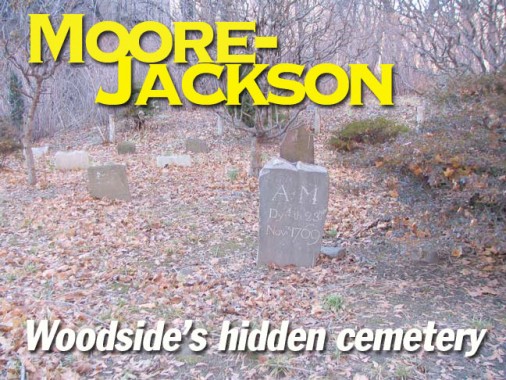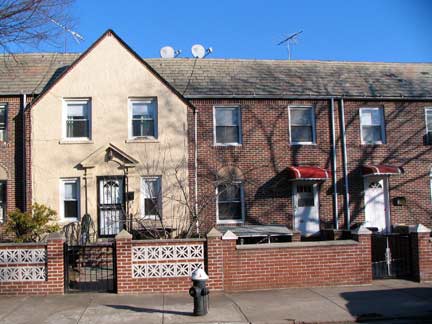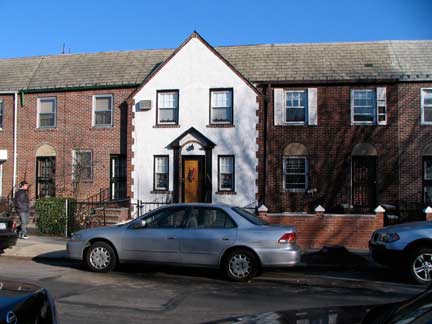Queens is dotted with minuscule cemeteries, some still existing, some as dead as the people who were buried within, whose remains are blown in the breeze now. Corona used to have a small cemetery on Alstyne Avenue that is long forgotten. TheBunn Cemetery on 46th Avenue and 165th Street in Flushing was recently rededicated after being cemented over by Robert Moses in the 1930s. Some, such as the Bayside Acacia Cemetery in Ozone Park, have become overgrown with weeds and neglect. Some, like the Brinkerhoff Cemetery, on 182nd Street in Fresh Meadows, are the centers of a tug of war between developers and preservationists.
Woodside and Elmhurst, Queens were home to the Moore family, the family that gave rise to Clement Clarke Moore, to whom the famed poem The Night Before Christmas is credited. Clement was the great-great-great grandson of Reverend John Moore, who became the first minister in the town of Middleburg (today’s Elmhurst) in 1656. His son, Captain Samuel Moore, built a house near today’s Broadway and 83rd Street, today the site of the Moore Homestead Park; Samuel Moore Jr. built a farmhouse near 31st Avenue and 54th Street in 1701 (demolished about 1900) and owned about 100 acres of surrounding woodland in the 18th Century. Family descendant Nathaniel Moore, Jr. stipulated in his 1827 will that his real estate on either side of Bowery Bay Road (today’s 51st street) be sold after his death, with the exception of the family burial ground, located today on the west side of 54th Street between 31st and 32nd Avenues.
The cemetery was established by 1733 (the date of the earliest known burial) and has been known as the Moore-Jackson Cemetery since John Jackson married into the family and added to the cemetery’s acreage. He was, however, buried in the churchyard of St. James Episcopal Church on Broadway in Elmhurst. The last interment in the cemetery was in 1867.
54th Street north of Northern Boulevard. The quiet street, formerly numbered 2nd Street before the Queens Topographical Bureau adopted one set of street numbering for Queens beginning in 1915, gives no sign that a historic cemetery can be found just to the north. These handsome attached brick houses appear to have been built in the 1920s.
Then, once you’re past 32nd Avenue, there it is, an open area behind a chain link fence, a few gravestones poking up from the barren winter ground, marked by a rusted sign that has been here a long time. This is more than most neglected cemeteries in Queens (and also Staten Island) get; the Brinkerhoff Cemetery is simply an open area of woods, while the Cornell Cemetery in Far Rockaway is completely surounded by private property and is inaccessible to the public.
Moore-Jackson Cemetery’s condition has waxed and waned over the centuries. By the 1910s, Nathaniel Moore’s dictum that it not be sold was holding firm, but the burial ground had become a weed-filled dump.
The Queens Topographical Bureau surveyed the cemetery in 1919 and was able to locate 42 identifiable monuments, which were inscribed on a survey map that you can find reproduced in Woodside: A Historical Perspective by Catherine Gregory (Woodside on the Move, 1994). When construction of the houses you see above began in 1924 the cemetery was used as a rubbish dump. The NYC Department of Health ordered it cleaned of weeds and litter, and by then it was so overgrown that workers were amazed to discover headstones within. The chain link fence was erected in 1956, but the cemetery continued to be plagued by neglect at times. By the 1990s a more concerted effort was made and the cemetery’s condition has stabilized.
There are just a handful of monuments remaining of the 42 that the topographical survey found in 1919, and most are in the back (the 51st Street side, out of range of my telephoto. But a couple do stand out, including Augustine Moore’s well-preserved 1769 stone which is right in the front. “x” was occasionally used to separate initials in this era. Records show that he was the son of Samuel Moore, Jr, and died at age 17. On the right is Samuel Hallett Moore’s stone, which reads: In memory of Samuel Hallett Moore, son of David & Jemima H. Moore, who departed this life June 26th, 1813 aged 23 years, 5 months & 15 days.
This one is especially tough to make out; it was apparently relocated from the back of the cemetery, which is where the QTB survey placed it. In any case, according to the list of gravestone inscriptions in Gregory’s book, it reads: In memory of Margaret, daughter of Bernard and Deborah Rapelye, who departed this life the 7th of October, 1790, aged one year and 11 months.
Photographed December 13, 2008; page completed December 15



